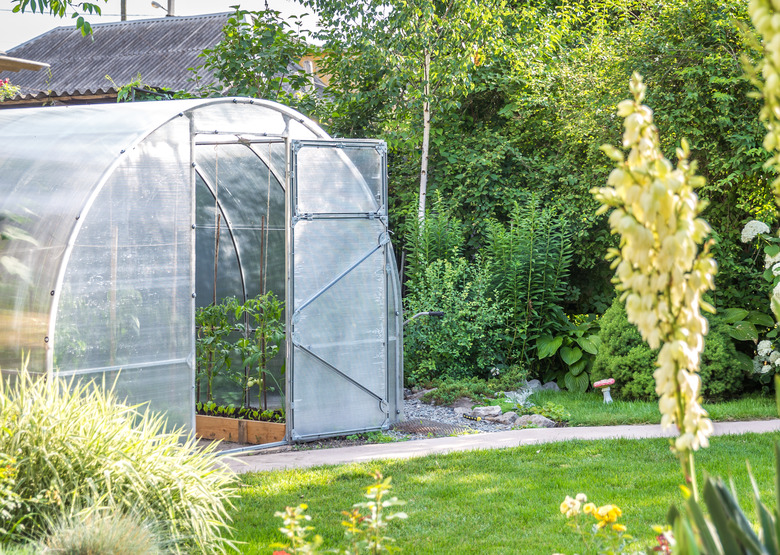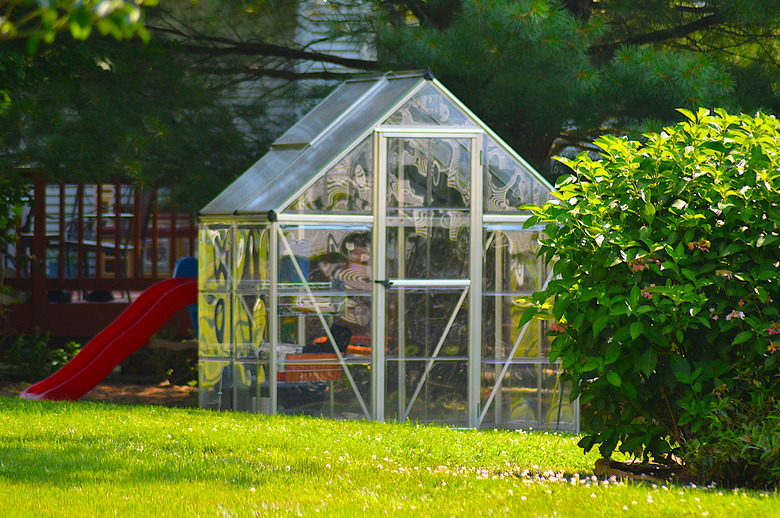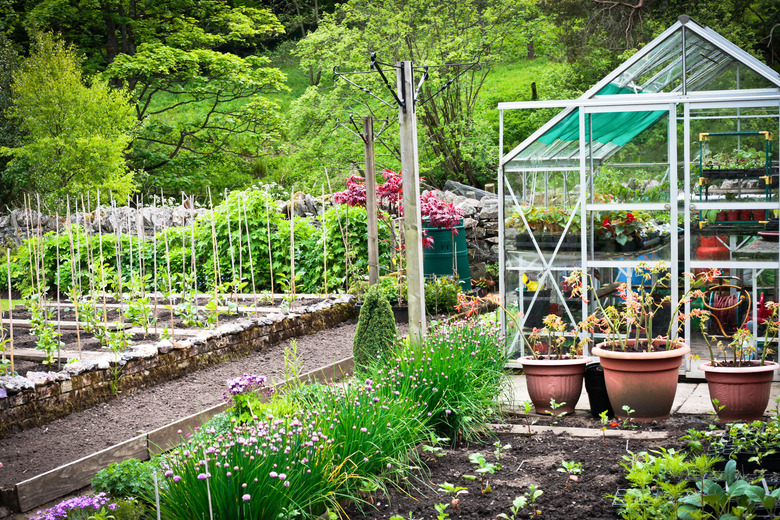How To Choose The Best Greenhouse Kit
We may receive a commission on purchases made from links.
If you've decided that you're tired of waiting until the growing season to play outside in the garden, it's time to consider greenhouse kits. Available in all different shapes and sizes, these kits allow you to easily construct a DIY greenhouse over the course of a weekend even if you have no experience designing and building such structures. The best greenhouse kits vary based on your specific needs and budget.
The key to choosing the right greenhouse kit for you is to understand how you intend to use the greenhouse. Your specific goals and plant choices will determine how large your greenhouse needs to be, what type of covering you'll need to use, and even what kind of frame will work best. The many options may seem overwhelming at first, but you can quickly narrow them down once you get a good sense of your goals (as well as how complicated it is to put together).
Thinking about purchasing a greenhouse kit? Here's how to choose the best one for your needs.
1. Know Your Construction Limits
1. Know Your Construction Limits
You may have dreams of a glorious hobby greenhouse that fills most of your backyard with easy access to home-grown produce year-round, but your homeowners' association or the local building code may have a very different vision. Before you start shopping for (and falling in love with) greenhouse kits, make sure you know what you're allowed to have. Local zoning rules and homeowner association guidelines may both limit the size of your greenhouse and where it is placed within your yard or how closely it sits to your house.
2. Plan How You Want to Use the Greenhouse
2. Plan How You Want to Use the Greenhouse
When choosing a greenhouse kit, it's also important to know what you intend to do with your growing space. There are three different "types" of greenhouses, and which one you select depends on whether you want to germinate seeds, grow flowers and vegetables, or grow tropical plants.
Germinate Seeds
A cool greenhouse, also known as a frost-free greenhouse, is one that maintains a steady temperature of 40 to 45 degrees Fahrenheit. These are the best greenhouse kits for those on a tight budget who simply want to germinate seeds for transplanting into the garden later.
Grow Flowers and Vegetables
If you want to grow flowers or vegetables all season long, you'll need a warm-greenhouse kit. Warm greenhouses stay between 50 and 55 degrees Fahrenheit all year but require a heater to do so. Your kit won't come with a heater or electrical wiring, so you'll have to add it yourself, which adds to your greenhouse expenses. You may also find that you need to use grow lights to supplement short winter days.
Grow Tropical Plants
If your tastes lean toward the tropical, hot-house structures are the best greenhouse kits for you. These greenhouses maintain temperatures between 65 and 70 degrees Fahrenheit. Doing so requires heat, which doesn't come with the greenhouse kit. Coverings do come with your kit, and you'll need one with adequate insulation to help maintain the proper temperature inside your greenhouse. This can increase the kit's purchase price.
Tip
When you start shopping for greenhouse kits, you won't find them labeled in this manner, which is why it's important to know your intended purpose for the greenhouse so you can choose the right greenhouse kit for you. If you want a hot house, for example, you'll need to choose a greenhouse kit with a higher insulation-value covering than you would need for a cool greenhouse.
3. Choose the Right Frame and Foundation
3. Choose the Right Frame and Foundation
When shopping for high-quality greenhouse kits, you need to choose the right frame and foundation for you. Here's what to know about greenhouse frames and foundations.
Types of Greenhouse Frames
- Aluminum: Aluminum is strong and sturdy but lightweight and easy to maneuver during assembly, and it doesn't rust, making it a long-lasting option. An aluminum frame is the most popular choice for home gardeners.
- Plastic resin: These frames are quite attractive and less expensive than aluminum. However, they're also not quite as sturdy, making them a good choice for only small greenhouses. Plastic frames limit your choice of greenhouse coverings since there is a limit to how much weight they can support.
- Wood: Another very sturdy option for greenhouse frames is wood. Lumber is both an attractive and strong building material. When using it for a greenhouse frame, however, it's important to think about your greenhouse's foundation. Because of the potential for rot, wooden greenhouse frames should not sit directly on the ground unless the wood has been treated against rot and insects. It's best to set wood foundations on cement blocks or a gravel base to protect it from rot.
Types of Greenhouse Foundations
- Gravel foundation: This type of foundation often works best for a garden greenhouse base and floor since it provides excellent drainage when watering your seeds or plants.
- Concrete and brick: Concrete and brick pavers also work well, particularly if you have a walk-in greenhouse and you don't plan to plant anything directly in the ground.
- Bare ground: You can leave bare dirt if you wish to plant directly in the ground. You'll only get away with this if your soil drains well, however. Heavy, easily compacted soils allow water to sit on the surface rather than quickly draining away.
- Cement floor: If desired, you can also use a cement floor and foundation. If you go this route, you'll have to figure into your budget both the cost of the concrete foundation and the cost of adding proper drainage to it.
4. Select the Best Greenhouse Covering
4. Select the Best Greenhouse Covering
When choosing the best coverings for your greenhouse frame, there are several factors you need to consider. One is the potential weight that the structure will bear. If you live in an area where there's often inclement weather conditions like snow or heavy rainfall, you'll need a heavy-duty greenhouse covering that can support the weight.
Be mindful of potential dangers around your greenhouse as well. Do you have kids who will play baseball near your greenhouse? If so, avoid glass and easily shattered or damaged greenhouse coverings. Does it snow where you live? If so, you'll need a roof that can support a bit of weight.
You also need to know how much light and insulation a greenhouse covering will provide. For many gardeners, the best greenhouse kits use polycarbonate glazing. Polycarbonate panels contain air space that help provide insulation and diffuse light well. They also have enough durability to withstand some wind and snow without cracking or failing.
A fiberglass greenhouse covering is another appealing option. Because it's translucent, fiberglass diffuses the light entering the greenhouse. This is excellent since many greenhouse plants do better with diffused light than direct sunlight, which can quickly overheat them. Over time, however, fiberglass becomes etched and turns yellow. Fiberglass is also corrugated to increase its rigidity, and dirt and moss can both find their way into the ridges.
Tempered glass is the most durable greenhouse roof and wall material, but it's also the heaviest and the most difficult to install. Tempered glass is made in such a way that it shatters into small even pieces without sharp edges when it breaks. Tempered glass provides very little insulation and is usually clear — this clarity makes it better for seed starting than for maintaining mature plants.
Polyethylene film is another popular choice because it's inexpensive. Essentially just a plastic cover, polyethylene is translucent so it diffuses light a bit. Unfortunately, it's not all that strong. It will stretch or sag when exposed to high winds or snow loads. It also provides very little insulation. Expect a polyethylene cover to last only about three to five years.
Other Greenhouse Kit Considerations
Other Greenhouse Kit Considerations
Although we often think about keeping a greenhouse warm so we can keep growing in the winter, remember that greenhouses often get quite hot in the summer. It's important to purchase a greenhouse kit that provides adequate ventilation.
Although you can open ventilation ports and louvers manually, consider getting a kit with automatic ventilation controls. Most use solar power to open and close the vents as needed so you don't need an electricity hookup. Automatic systems help make sure your plants don't overheat while you're away on vacation or stuck at work during a hot afternoon.
Even if you're planning to start small, gardening can undoubtedly become an addiction. If you think you may want to expand later, look for a greenhouse kit that lets you add on. This way, you won't have to start from scratch if you later decide you need more space.
You may also want to consider a kit with rain gutters. Gutters aren't strictly necessary for a greenhouse, but having them provides an easy way to collect water in a rain barrel. Positioning the barrel just outside your greenhouse keeps it close and convenient.
Always compare warranties when comparing greenhouse kits and look for kits treated with UV protection. Your greenhouse will spend its life standing in the sun, exposed to UV rays constantly. Without sufficient UV protection, you may find it fading, cracking, peeling and otherwise succumbing to the elements.


